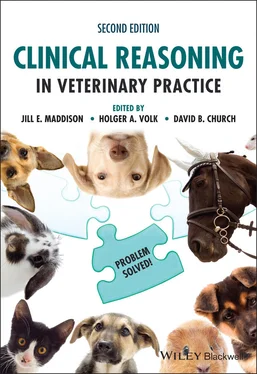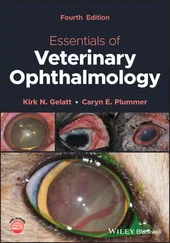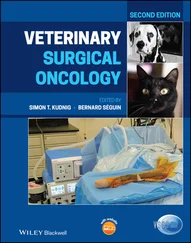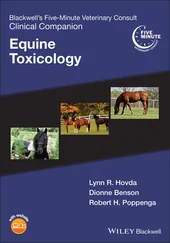Clinical Reasoning in Veterinary Practice
Здесь есть возможность читать онлайн «Clinical Reasoning in Veterinary Practice» — ознакомительный отрывок электронной книги совершенно бесплатно, а после прочтения отрывка купить полную версию. В некоторых случаях можно слушать аудио, скачать через торрент в формате fb2 и присутствует краткое содержание. Жанр: unrecognised, на английском языке. Описание произведения, (предисловие) а так же отзывы посетителей доступны на портале библиотеки ЛибКат.
- Название:Clinical Reasoning in Veterinary Practice
- Автор:
- Жанр:
- Год:неизвестен
- ISBN:нет данных
- Рейтинг книги:3 / 5. Голосов: 1
-
Избранное:Добавить в избранное
- Отзывы:
-
Ваша оценка:
- 60
- 1
- 2
- 3
- 4
- 5
Clinical Reasoning in Veterinary Practice: краткое содержание, описание и аннотация
Предлагаем к чтению аннотацию, описание, краткое содержание или предисловие (зависит от того, что написал сам автор книги «Clinical Reasoning in Veterinary Practice»). Если вы не нашли необходимую информацию о книге — напишите в комментариях, мы постараемся отыскать её.
Clinical Reasoning in Veterinary Practice: Problem Solved! 2nd Edition
Clinical Reasoning in Veterinary Practice: Problem Solved! 2nd Edition
Clinical Reasoning in Veterinary Practice — читать онлайн ознакомительный отрывок
Ниже представлен текст книги, разбитый по страницам. Система сохранения места последней прочитанной страницы, позволяет с удобством читать онлайн бесплатно книгу «Clinical Reasoning in Veterinary Practice», без необходимости каждый раз заново искать на чём Вы остановились. Поставьте закладку, и сможете в любой момент перейти на страницу, на которой закончили чтение.
Интервал:
Закладка:
 Define the location
Define the location
In cases of diarrhoea, the problem‐based system we discussed in Chapter 2is applied, but in a slightly different order. Identification of the location occurs first , which then assists in defining the system. This is because, almost always, large bowel diarrhoea reflects primary GI disease, whereas small bowel diarrhoea can occur with either primary or secondary GI disease. Thus, defining the location first aids in defining the system.
A thorough history is essential to differentiate small from large bowel disease. It is important to carefully question the owner as to the character of the faeces and to elicit information regarding consistency, colour, frequency and presence of blood or mucus. Related abnormalities should also be assessed, such as whether there has been significant weight loss, loss of appetite or vomiting. The characteristics of small and large bowel diarrhoea are detailed in Table 4.1.
Because large bowel diarrhoea has fewer and more specific characteristics than small bowel diarrhoea, it is often easiest to note if there is any fresh blood, mucus and small amounts of faeces passed frequently. If the diarrhoea has none of these characteristics, then the patient has small bowel diarrhoea. Note also that diarrhoea may have features of both small and large bowel, which indicates either primary small bowel with secondary effects on the lower bowel or diffuse disease involving both the small and large intestine.
Table 4.1 Characteristics of small and large bowel diarrhoea.
| Small bowel diarrhoea | Large bowel diarrhoea | |
|---|---|---|
| Consistency, volume and pattern | Faecal volume and/or water content is increased. Diarrhoea may be projectile and does not usually involve significant tenesmus or urgency. | Small amounts of faecal material are passed frequently. Tenesmus and urgency are often present, particularly if the lower colon or the rectum is involved. |
| Blood | If blood is present, it is usually digested (melaena) or, in acute diarrhoea, reddish‐brown. | If blood is present, it will be undigested (haematochezia). |
| Appearance | Colour may be grey if large amounts of undigested fat are present. A yellow‐green coloration is common and due to malabsorbed bile salts. | Mucus is often present either on the surface (indicating the lesion is in the lower colon or rectum) or throughout the faeces (indicating a lesion in the higher colon). |
| Weight loss | Chronic small bowel diarrhoea is often (but not always) associated with weight loss. | Usually there is no weight loss caused by large bowel diarrhoea per se but there may be as a result of the pathology such as severe inflammation or neoplasia. |
| Vomiting | Vomiting may also be present (but need not be). Relationship to eating can be variable depending on the location of the lesion. | Vomiting can occur occasionally but is infrequent and is unrelated to eating. |
| Borborygmus and flatulence | Gas commonly occurs with small bowel diarrhoea, as malabsorbed carbohydrates are fermented by colonic bacteria producing CO 2and H 2S. | Uncommon. |
| Appetite | Appetite may be variable depending on the underlying aetiology. | Usually, the appetite is unaffected. |
| Water balance | If the diarrhoea is severe, the animal may be dehydrated. If the diarrhoea is very watery, the patient may have an increased water intake. | Large bowel diarrhoea per se does not usually adversely affect water balance. |
| Physical examination | Physical examination may reveal increased gas or thickened loops of bowel but is often unrewarding. Always do a rectal examination to check for melaena or large bowel signs such as mucus and fresh blood about which the owner may not be aware. | Physical examination is often unremarkable, but it is imperative to do a rectal examination if possible to check for strictures, masses or thickened mucosa. |
 Define and refine the system
Define and refine the system
Diarrhoea can be due to primary disorders of the small bowel and/or large bowel or due to other systemic, secondary GI disorders such as hepatic disease, exocrine pancreatic insufficiency, pancreatitis, hyperthyroidism or hypoadrenocorticism. As discussed earlier, large bowel diarrhoea is almost always due to primary GI disease, whereas small bowel diarrhoea may occur with either primary or secondary GI disease.
Severe systemic diseases such as sepsis and uraemia can cause large bowel diarrhoea, but this will be a very minor clinical sign in relation to the patient’s other systemic clinical signs. Thus, secondary disorders are not usually likely differentials when considering the work‐up of a patient whose primary problem is large bowel diarrhoea.
Diarrhoea due to primary GI disease is more common than diarrhoea due to secondary GI disease. In animals with secondary GI disease, with the exception of exocrine pancreatic insufficiency and some dogs with hypoadrenocorticism, diarrhoea is not usually the primary presenting complaint.
 Define the lesion
Define the lesion
The following tables summarise the causes of acute and chronic small and large bowel diarrhoea ( Tables 4.2– 4.4).
Table 4.2 Causes of acute small bowel diarrhoea in dogs and cats.
| Cause | Examples | Comments |
|---|---|---|
| Diet related | Overeating (especially puppies)Dietary changeSpoiled foodDietary indiscretion | Including change to food that causes allergy/hypersensitivity. |
| Parasites/protozoa | ParasitesMost commonly ascarids ( Toxocara and Toxascaris spp., also hookworms Ancylostoma and Uncinaria spp.) Protozoa Giardia spp.Coccidia, for example Cystisospora spp. (formerly called Isospora ) Cryptosporidium spp. | Zinc sulphate flotation is a sensitive test for Giardia cysts, provided three faecal samples collected over 5 days are examined (∼95% sensitive).The ELISA test can identify Giardia antigen in faeces. The test is reported to be about 90% sensitive and is probably more sensitive than performing zinc sulphate flotation examination on a single faecal sample.Faecal IFA and PCR are also available.A negative result does not necessarily exclude Giardia infection, and some clinicians will treat with metronidazole or fenbendazole regardless and proceed with further investigations only if the diarrhoea persists. |
| Infection (bacterial/viral) | Viral enteritisParvovirus/panleukopeniaCoronavirusDistemperFeline immunodeficiency virus (FIV)/Feline leukaemia virus (FeLV)Other viruses (e.g. adenovirus, norovirus, torovirus)Bacterial enteritis Campylobacter spp. Salmonella spp. E. coli Clostridium spp. | Microbial culture of faeces is often unrewarding due to the abundant normal flora in the gut and the predominance of anaerobes. E. coli is frequently, and Salmonella is sometimes, isolated from faeces of normal animals, and therefore their presence does not necessarily imply that they are the cause of the diarrhoea. Campylobacter spp. and Clostridium spp. are also found in animals with and without diarrhoea, which makes interpretation of results quite difficult. Clostridium perfringens and Clostridium difficile have equal prevalence in dogs with and without diarrhoea. However, there is a correlation between the presence of diarrhoea and the detection of toxins that are produced by these bacteria, although enterotoxin can also be found in healthy dogs.Identification of an overgrowth of Clostridia or Clostridial spores on faecal smears means nothing diagnostically and will occur in many situations when gut flora is disturbed by a variety of GI disorders. |
| Toxins | ToxinsLeadOrganophosphatesPlants *Ingestion of many toxins can cause acute diarrhoea sometimes in combination with other systemic signs | Plants that may cause diarrhoea if ingested (as well as other clinical signs) include:Lily of the valleyDaffodil bulbsAloe veraAsparagus fernChrysanthemumsCyclamens. |
| Unknown | Acute haemorrhagic diarrhoea syndrome (AHDS) | Previously called haemorrhagic gastroenteritis (HGE). This is a syndrome causing acute onset of vomiting and bloody diarrhoea.Characteristically the patient will have significant haemoconcentration (increased packed cell volume [PCV]) with a normal or low plasma protein due to protein loss into the bowel. It is typically described in small breed dogs but any size/breed can be affected.It is now believed that the cause may be novel necrotising toxin produced by Type A Clostridia perfringens .However, antimicrobial therapy does not improve outcome unless the patient is septic. |
| Secondary GI disease | Acute pancreatitisSevere systemic disease | See previous comments regarding presence of other clinical signs. |
Table 4.3Causes of chronic small bowel diarrhoea in dogs and cats.
Читать дальшеИнтервал:
Закладка:
Похожие книги на «Clinical Reasoning in Veterinary Practice»
Представляем Вашему вниманию похожие книги на «Clinical Reasoning in Veterinary Practice» списком для выбора. Мы отобрали схожую по названию и смыслу литературу в надежде предоставить читателям больше вариантов отыскать новые, интересные, ещё непрочитанные произведения.
Обсуждение, отзывы о книге «Clinical Reasoning in Veterinary Practice» и просто собственные мнения читателей. Оставьте ваши комментарии, напишите, что Вы думаете о произведении, его смысле или главных героях. Укажите что конкретно понравилось, а что нет, и почему Вы так считаете.












